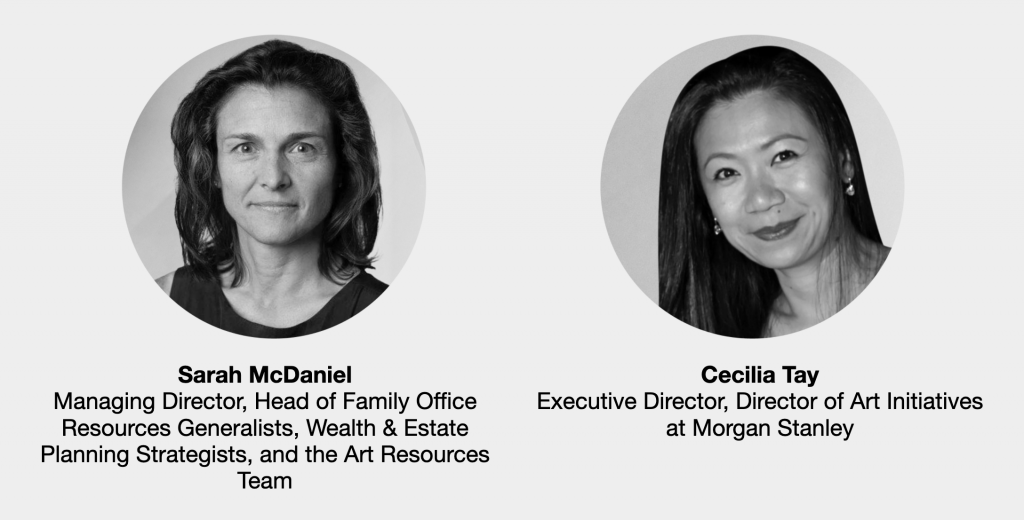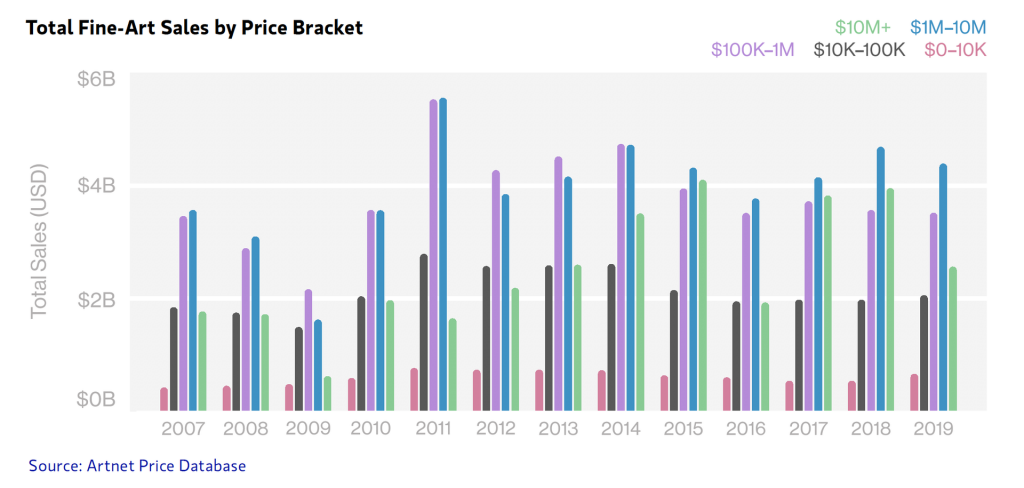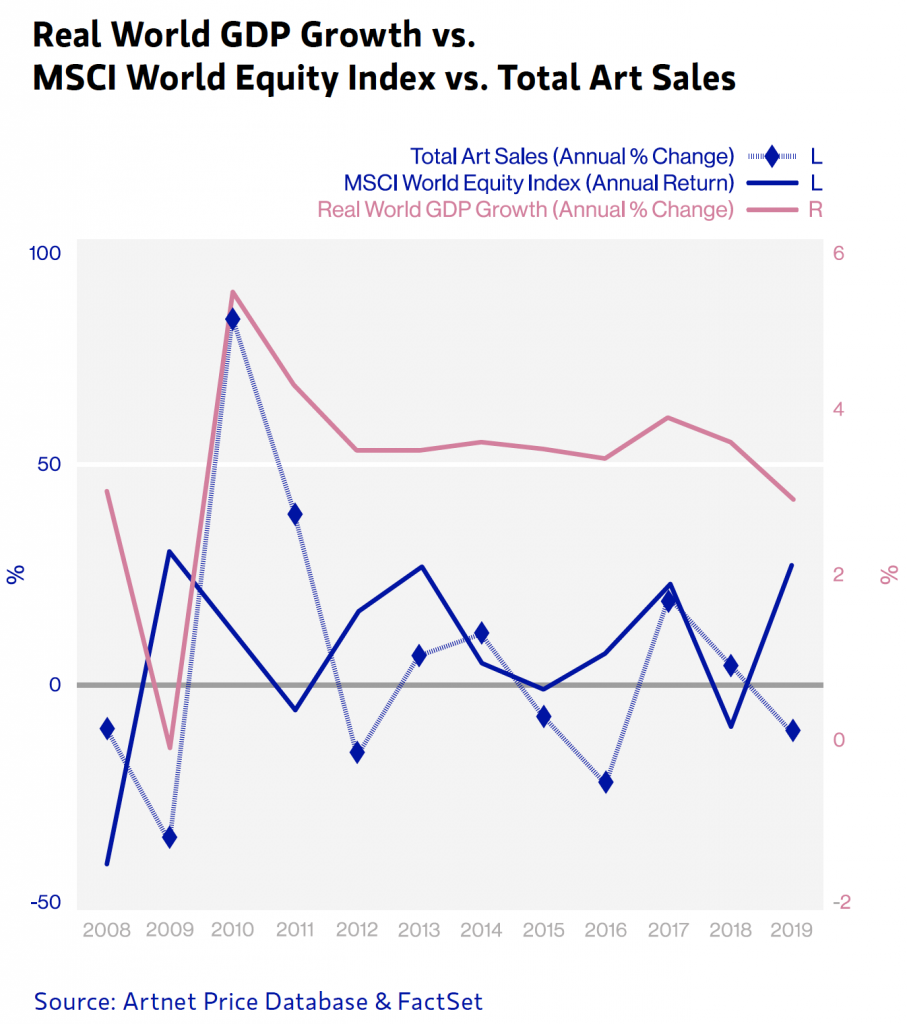Art World
15 Minutes With Morgan Stanley’s Art Resources Team
We caught up with Sarah McDaniel and Cecilia Tay, two of the leading experts on art and wealth management.

We caught up with Sarah McDaniel and Cecilia Tay, two of the leading experts on art and wealth management.

In Partnership with the Art Resources Team (ART) at Morgan Stanley

The Artnet Price Database is a trusted tool used by art-world insiders to buy, sell, and research art. Its users across industries—from auction houses to museums, galleries, and government institutions—represent the art world’s most important players. We’re taking 15 minutes to chat with some friends of Artnet to get their take on the current state of the market and how they’re keeping up with the latest trends.
When it comes to wealth management and art, Morgan Stanley’s Art Resources Team (ART) is poised to create customized strategies and offer solutions that help address the unique challenges of art as an asset. From curating internal and external resources to consulting with collectors to help them with structural, investment, and lifestyle decisions, ART creates bespoke solutions for every client and collection.
We had the chance to chat with Sarah McDaniel, Managing Director, Head of Family Office Resources Generalists, Wealth & Estate Planning Strategists, and the Art Resources Team, and Cecilia Tay, Executive Director, Director of Art Initiatives at Morgan Stanley about what it’s really like to work at the intersection of art and finance.

Claude Monet’s Meules (1890), which sold for over $110 million at Sotheby’s in 2018. Image courtesy of Wikimedia Commons.
What are some considerations for owning art that are important to keep in mind?
SM: A collector may segment wealth into two groups: financial assets (including stocks, bonds and real estate) and other physical possessions, such as art. This separation is sometimes the result of art being considered a personal interest rather than an asset. Generally, art prices have increased significantly over the past decades, so a piece that a collector purchased many years prior for a modest amount of money or inherited may now be quite valuable. A piece that the collector considered decorative for years may not be perceived to have value and because of this, consideration of its value is not included in the strategic planning process. Underestimating the value of a potential future estate may result in insufficient planning, higher taxes and liquidity challenges. Clients may be advised to consult with an appraiser to do a preliminary assessment of the collection to understand which pieces may warrant a formal appraisal and inclusion in trust, tax and estate planning.
CT: First, buy what speaks to you. I once heard someone say that the dividends that art provides are only for the eyes, and I concur! Next, be sure to look at a lot of art before the purchase, and always do your provenance checks. Also, I truly believe in stewardship of the artworks so that the art can live on longer than we can. During our lifetime, part of owning art means there might be maintenance costs to upkeep the condition, insurance costs, and the like. Finally, estate planning is another aspect to focus on, which, of course, philanthropy is also a conversation we have with our clients.
Sarah, in your work with the Art Resources Team, you’ve mentioned that you curate resources for collectors and help them think through strategy. What are some of these resources? What does it look like to customize solutions for clients?
SM: MS ART leads collectors through Family Office Resources’ strategic decision making process which includes structural (Governance), investment (Wealth Strategies) and behavioral (Lifestyle) decisions. Here are a few strategic questions and potential considerations that would help us identify bespoke solutions:
For example, what happens if a collector is not sure what to do with their collection after their death—this falls under Governance. Is the intention to keep it together? Who will oversee the art? Do the beneficiaries want the art? The solution might include creating a governance structure to determine who makes the decisions and ensuring documentation of how decisions are made.
In terms of Wealth Strategies, owning and maintaining art may cause issues to arise, as art is a relatively illiquid asset. You have to think about the cash flow needed to maintain the collection, the impact of the purchase on the balance sheet, and how to pay estate taxes without selling art. In this case, one solution would be to create a comprehensive wealth management strategy where borrowing may complement investments, so that there is increased flexibility and some of the costs of maintaining art might be alleviated.
Lastly, Lifestyle questions can be related to the flow of information about the art market. How do you buy and sell art? How is art valued? How do you maintain a collection? This is the area where we may suggest engaging an art advisor to consult on valuation, collection management, purchases and sales.

Total fine-art sales at auction by price bracket from 2007 to 2019. Graph courtesy of Artnet.
Cecilia, you have said that your experience as a financial advisor helps you in your role as the Director of Art Initiatives. How do you balance art and financial consulting? What do you think are the parallels between the two experiences?
CT: The role of a financial advisor and the existing role as the Director of Art Initiatives have more overlap than I had imagined. Ultimately, we work with UHNW clients and together we discuss the dynamics of their families, their needs today and tomorrow, and how to leave behind their legacy for their heirs. In both roles, trust is paramount in all that we do. Sometimes when dealing with clients, reading between the lines and sensing the unspoken word can orchestrate creative and unexpected outcomes. Having started out as a financial advisor definitely helped shape this qualitative skill further.
While it is not definitively known what portion of annual art sales is attributable to non-financial versus financially motivated buyers, over time, prominent business people from finance, technology and real estate have been publicly vocal about declaring art as an asset class.
Over the course of your careers, how have you seen the market for art change as the financial markets have changed?
SM: While it is not definitively known what portion of annual art sales is attributable to non-financial versus financially motivated buyers, over time, prominent business people from finance, technology and real estate have been publicly vocal about declaring art as an asset class. Interestingly, the evolution of real estate as a definable and measurable asset provides precedence for art in that real estate and art present similar yet not insurmountable challenges. These challenges include: each asset is unique; valuations can be challenging given few if any direct comparables exist; both are highly illiquid; buying, holding and selling costs are considerable; and buying and selling is infrequent.
CT: Wealth creation from the capital markets has played a significant role in shaping the art market. As financial markets have become globally correlated, so, too, has the art market. Twenty years ago, art collecting in Asia was not as vibrant as it is today. Looking at Hong Kong as an example—the art fairs, opening of gallery spaces, and newly created wealth have helped nurture the art scene. Technology has been a major contributor to the evolution of the art market globally.

A look at the fine art market vs. the world financial markets. Graph courtesy of Artnet.
What was your first memorable experience with art?
SM: Growing up, my mother introduced me to the many extraordinary museums in and surrounding Philadelphia. The Barnes was a particular favorite. With each successive visit over the years, she taught me more about the artists, the collector and the institution. We oftentimes would begin our experience in each room by standing in the center and using the works as living flashcards to identify the artists, styles and themes before more closely examining each of them. These experiences inspired and have sustained my appetite for art and travel for decades.
CT: My first encounter with art was The Hallucinogenic Toreador by Salvador Dali, which led me to study Spanish in order to visit Dali’s museum in Figueres, Spain. During the same trip, not only did I dream of living in Antoni Gaudi’s La Pedrera in Barcelona, I visited Museo del Prado (Las Meninas!), Museo Reina Sofia, and Thyssen-Bornemisza Museum in Madrid; and Guggenheim Museum in Bilbao (where I first experienced Richard Serra’s works). My love for art was born.
What do you personally collect?
SM: Curiously, because of—or in reaction to—my love of fine art as a result of studying it, visiting museums globally, and beginning my career at Christie’s, I have not surrounded myself with pictures, but rather functional objects and furniture from the 19th and 20th centuries. I enjoy the craftsmanship, the textures and characteristics of the materials as well as the structural compositions.
CT: Contemporary art. Our latest acquisitions are works by Rashid Johnson, Paul Sietsema, Alex Da Corte, Julian Opie, Yuji Agematsu, Nolan Simon and Leidy Churchman. My husband is a big fan of British sculptors Tony Cragg and William Turnbull.
This article is not and should not be interpreted as an endorsement or approval by Morgan Stanley of (i) the Artnet Price Database, and (ii) the views or statements of the interviewer and/or interviewee. To the extent permitted by law, Morgan Stanley disclaims any liability for the accuracy or completeness of any information provided in the article. Morgan Stanley does not advise on the purchase or sale of art and this should not be construed as a recommendation of any artists or genres.
This material has been prepared for informational purposes only. The information contained herein is from multiple sources deemed to be reliable but is not guaranteed and do not necessarily reflect the views, opinions or advice of Morgan Stanley Smith Barney LLC (“Morgan Stanley”) or its affiliates. Morgan Stanley is not responsible for the information contained in this material. It has been prepared without regard to the individual financial circumstances and objectives of persons who receive it. It is not a recommendation to purchase or sell artwork nor it is to be used to value any artwork. Investors must independently evaluate particular artwork, artwork investments and strategies, and should seek the advice of an appropriate third-party advisor for assistance in that regard as Morgan Stanley Smith Barney LLC, its affiliates and employees including Morgan Stanley Financial Advisors and Private Wealth Advisors do not provide advice on artwork nor provide tax or legal advice. Investors should consult their tax advisor for matters involving taxation and tax planning and their attorney for matters involving trusts and estate planning, charitable giving, philanthropic planning and other legal matters.
Morgan Stanley Smith Barney LLC. Member SIPC. CRC 3422107 2/2021